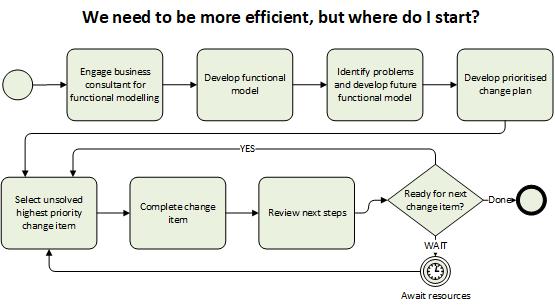I need to boost business efficiency, where do I start?
By Peter Meyer, Principal Consultant, Elkera Pty Limited
1 July 2025
Many medium-sized commercial and not-for-profit organisations reach a stage in their life cycle where they face a critical challenge. Either:
- They have grown quickly and are now struggling internally to manage that growth; or
- They are relatively mature and under increasing pressure to remain sustainable. This is particularly true for not-for-profits that rely on government or philanthropic funding.
Organisations facing those challenges are likely to also experience growing internal pressures:
- Staffing feels misaligned
- Systems no longer support how people work
- Processes are unclear
- Productivity seems low
- Financial constraints are very real.
Leaders may feel the organisation has become unwieldy and hard to steer.
It’s easy to feel overwhelmed. Board meetings become tense. Staff report being overloaded. Managers propose isolated fixes without understanding the bigger picture. Vendors pitch new tools and AI solutions. For not-for-profits, funders and stakeholders often make demands without understanding how the organisation actually operates.
Organisations facing either of the critical challenges identified earlier must address two interlinked strategic questions:
- What is the organisation’s future direction?
- How can it be made fit for purpose to support that direction?
Whether the goal is consolidation or new growth, one thing is essential: the organisation must be fit for purpose. It needs to operate efficiently, control costs, and adapt to change if it is to thrive.
The first strategic question, future direction, must be addressed. But the second, organisational fitness, is often neglected or mishandled.
This article focuses on that second question. How do you begin the process of making your organisation fit for purpose?
Don’t ignore the problem
Organisational problems don’t go away on their own. Left unaddressed, they slowly drain the vitality from the organisation. Every time a problem is ignored, it becomes more acceptable to ignore the next one. Over time, the costs mount, good staff leave, and performance erodes until someone takes action or the organisation declines beyond repair.
Start with understanding, not a supposed solution
When leaders are under pressure, the instinct is to act quickly, to quieten the noise. You might consider:
- Investigating new software
- Bringing in a consultant
- Restructuring teams
- Launching a new internal planning process.
These actions may eventually be necessary, but only when taken in the right sequence and within the right context.
Poorly planned, piecemeal change efforts often solve the wrong problem and create new ones. For example, if a department head pushes for new software, how do you know it’s a real priority? How can you be sure the software will deliver value?
The software vendor won’t fully understand your needs unless you can explain them clearly. Without doing a thorough analysis and developing clear requirements, the product you select may be unsuitable or simply unnecessary.
In addition to wasting time and money, ineffective projects undermine confidence and make it harder to get buy-in from staff for the next change initiative.
You can only prioritise effectively when you understand how the organisation actually works, as a complete system. What does your business do? How is it organised? Who performs the work? From that understanding, you can identify, assess and prioritise problems.
Build a functional model of the organisation
A recommended starting point is to create a functional model of how your organisation currently operates. This is a structured but accessible way to understand what your business does and how key functions are distributed and managed.
I explain the concept in more detail in a separate article: Growing pains for medium businesses: Why you should clearly define internal business structure.
At its core, a functional model identifies:
- Primary functions that directly produce and deliver business outputs, using a value chain approach
- Support functions such as HR, finance, IT, marketing, and legal, and how they relate to the primary functions
- Top-level processes within each function
- The roles primarily responsible for each function or process
- Key collaborators who contribute to the function’s success.
You can later break these processes down into sub-processes as needed for more detailed analysis and process improvement.
Make the problems visible
The functional model gives you a clear picture of the organisation’s functions, processes, roles and responsibilities. It enables you to ask the right questions:
- Are process flows being blocked by siloed teams or thinking?
- Are there manual tasks that could be automated?
- Are people doing work that adds little value?
- Are performance accountabilities clearly defined?
- Is the allocation of functions among managers effective?
- Are some areas over-resourced or under-resourced?
- Do managers have the information they need to make decisions?
- Is data being recorded in multiple places due to disconnected systems?
- Are critical processes being managed informally, or not owned by anyone?
With those insights, you can begin making deliberate, confident decisions about how to make the organisation truly fit for purpose.
The next steps to business efficiency
1. Define the future state functional model
Your current state model helps you diagnose problems. The next step is to define how the organisation should operate.
Identify the required changes and update the model to reflect this target design. That becomes the foundation for planning.
2. Develop a prioritised change plan
You won’t be able to fix everything at once. Many improvements will require staged implementation.
Some changes may involve:
- Restructuring roles and responsibilities
- Introducing or replacing software systems
- Clarifying processes or documentation
- Redesigning how work flows between teams.
So that you can achieve the highest return from your investments, changes should be prioritised, based on:
- Business value
- Risk
- Cost
- Implementation effort.
A step-by-step plan builds internal capability and maintains momentum, while reducing risk and cost.
3. Make early low-cost improvements
The functional model and change plan will likely highlight some changes that require little more than clarifying roles or refining internal processes. You can implement those changes quickly to gain early wins and build confidence in the process.
4. Work deliberately through the change plan
Your prioritised change plan will let you work through problems in a deliberate way based on the availability of staff and financial resources.
New software projects always require clear requirements. The functional model provides analysts with a solid starting point for defining software requirements.
Conclusion: Begin with understanding
Making your organisation fit for purpose starts with understanding how your organisation works as a system.
If you act without that understanding, you risk wasting time, money and energy on the wrong problems.
The investment you make in developing a functional model will produce multiple benefits. It will allow you to:
- Understand the real problems
- Break big challenges into manageable ones
- Prioritise wisely
- Solve problems systematically
- Save time and money by providing valuable foundational materials to requirements analysts and other consultants.
That’s how to begin making your business fit for purpose and ready to meet your strategic challenges.



